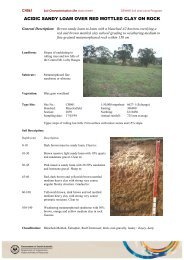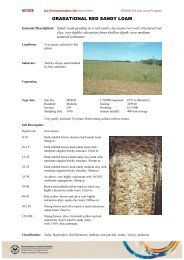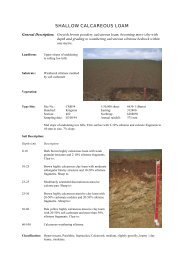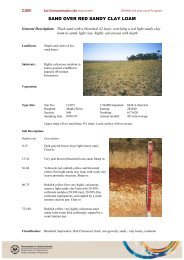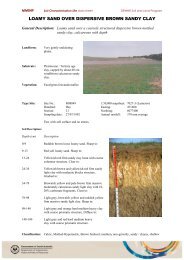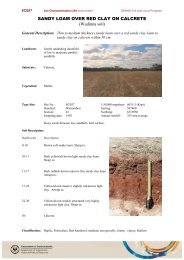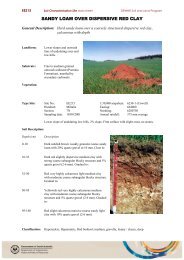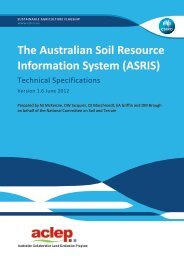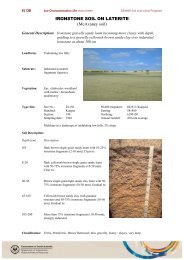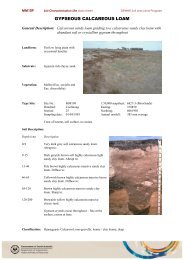Title: Atlas of Australian Acid Sulfate Soils Custodian: CSIRO ... - asris
Title: Atlas of Australian Acid Sulfate Soils Custodian: CSIRO ... - asris
Title: Atlas of Australian Acid Sulfate Soils Custodian: CSIRO ... - asris
You also want an ePaper? Increase the reach of your titles
YUMPU automatically turns print PDFs into web optimized ePapers that Google loves.
Positional accuracy (Coastal ASS component)<br />
Data has been captured at varying scales depending on location. Data collection scale for the respective<br />
areas are as follows.<br />
SA: 1:10K, 1:15K and 1:40K aerial photography<br />
Qld: 1:100K vegetation and topographic mapping, 1:100K Estuaries mapping<br />
Vic: 1:63K and 1:250K geology mapping, 1:100K soil-landform mapping and DEM derived from 1:25K<br />
topographic mapping, :100K Estuaries mapping.<br />
NSW: 1:25K maps.<br />
WA: 1:50K soil-landscape and geological mapping (Swan Coastal Plain) 1:100K geology and wetland<br />
mapping, 1:250K vegetation mapping (Northern WA) and 1:100K Estuaries mapping.<br />
NT: as per Coastal Waters Geomorphic Habitat Mapping (see below)<br />
Tas: 1:100K Estuaries mapping and unspecified Geological/geomorphology/Soil base maps, presumably<br />
1:250K<br />
ASS polygons derived from Coastal Waters Geomorphic Habitat Mapping<br />
Geomorphic habitat uni t boundaries have horizontal positional errors up to 100 metres, as<br />
they were digitised over 30 metre resolution Landsat TM 5 imagery. Positional accuracy<br />
checked by on-screen comparison <strong>of</strong> the data to Landsat TM 7 imagery. Coastal waterways<br />
with consistent errors greater than 100 metres block-shifted, to more accurately match<br />
Landsat 7 imagery. Inconsistent errors greater than 100m do exist in these data, when<br />
compared to Landsat 7 imagery; due in part to changes in coastal waterway morphology<br />
over time.<br />
Attribute Accuracy (Coastal ASS component)<br />
Attribute accuracy is as per the source data. Notes on the attribute accuracy <strong>of</strong> the respective areas taken<br />
from original metadata and associated documents are as follows. These state specific notes pertain to the<br />
original state ASS mapping layer received. For SA and NSW the polygon coverage is unaltered save for the<br />
dissolving <strong>of</strong> neighbouring polygons having the same NatCASS classification. For the rest, original state<br />
coverage has been modified or augmented with other layers.<br />
Attribute accuracy notes on those follow.<br />
SA<br />
Classification based on aerial photo interpretation, survey data, ground truthing and expert knowledge.<br />
NSW<br />
Mapped codes were checked as part <strong>of</strong> the GIS capture quality assurance procedures, including a visual<br />
check <strong>of</strong> polygon tags against field sheets following digital capture. Soil samples were taken in the field and<br />
analysed in the laboratory. During the field work phase, field meetings were held with ASS surveyors to<br />
ensure consistency in site selection strategies, soil pr<strong>of</strong>ile description methods and soil sampling techniques.<br />
Quality control and consistency in the mapping and coding <strong>of</strong> landform elements were also maintained by<br />
field checking by other ASS surveyors in the team and regular meetings to discuss and review the process<br />
Qld<br />
SE Qld: Occasionally, land has been mapped where there is actual acidity, but the oxidisable sulfur<br />
percentage may not exceed the `action level`. The reliability <strong>of</strong> elevation data is variable across the study<br />
area.<br />
Mangroves: approximately 80%<br />
Vic<br />
The mapped extent <strong>of</strong> probable ASS is based on a combination <strong>of</strong> knowledge and<br />
data, including formation processes, height above current sea level, geological mapping, soil<br />
mapping and site assessment. Due to the state <strong>of</strong> flux <strong>of</strong> the environment in which ASS form, and<br />
due to the processes that have occurred since their formation, the actual distribution <strong>of</strong> ASS is




